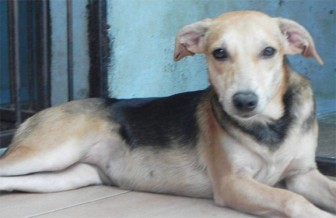Destruction of the Ball
of the Femur (Aseptic
Necrosis)
Aseptic Necrosis of the head (‘ball’) of the femur (that part of the thigh bone which fits into the ‘socket’ of the hip bone) is due to impaired blood supply to that ‘ball’. It leads to gradual destruction of the hip joint. Primarily, it occurs in young ‘toy’ dogs between four and ten months of age. Since there is so much inbreeding (incest) of these cute fluffy puppies, now being called ‘Pom-Peks’ (an absolute misnomer which deceives purchasers), Hip Joint Dysplasia and other musculoskeletal problems are increasing in incidence. Really there is need for the GSPCA and the police to investigate these ‘Puppy Farms’. In other breeds, it can be a sequel to sudden hip dislocation (auto accident).
Symptoms
The signs are severe lameness and refusal to bear weight on the leg. Muscle wasting is pronounced. There is a loss of motion at the joint and the leg can be shortened.
Slipping Kneecap
(Patellar Dislocation)
Dislocating kneecaps can be inherited or acquired through trauma. It occurs sporadically among ‘toy’ breed dogs (those ‘Pom-Peks’ again), although it can be found in large breeds, too.
 In dogs, the kneecap (patella) is a small bone which protects the front of the stifle joint; it is the counterpart of the kneecap in man. It is anchored in place by ligaments and slides in a groove in the femur (thigh bone).
In dogs, the kneecap (patella) is a small bone which protects the front of the stifle joint; it is the counterpart of the kneecap in man. It is anchored in place by ligaments and slides in a groove in the femur (thigh bone).
Conditions which predispose to dislocation of patella are: A shallow groove; weak ligaments; and mal-alignment of the tendons and muscles that straighten the joint. The patella slips inward or outward.

The signs of a slipped kneecap are: Difficulty straightening the knee; pain in the stifle joint; and a limp.
The diagnosis is confirmed by manipulating the stifle joint and pushing the kneecap in and out of position.
Treatment involves surgery to deepen the groove and/or the realignment of the tendon.
Popping Hock (laxity of
the Hock Joint)
This condition, which may affect one or both hocks, is due to looseness of supporting structures around the joint. It is more common in large dogs with straight rear end angulation. Usually it is not painful, but can impair the dog’s mobility and agility. In late stages, the joint can become arthritic.
Symptoms
The diagnosis can be suspected by observing the dog in motion, at which time the dog will exhibit an irregular gait. Manipulation of the joint reveals the lax ligaments. The hock slips out of place (either forward or to the side) when the joint is straightened.
Treatment
Early immobilization by splints (or cage rest) may reverse the condition in some young pups. The disease is carried in certain bloodlines. It can be reduced by proper breeding practices.
Elbow Dysplasia
(Disunited Anconeal
Process)
This condition (‘ED’) is caused by a faulty union of one part of an elbow bone with the ulna (forearm bone). Primarily it affects German Shepherd dogs and Basset Hounds, but has been described in other breeds as well. It is thought to be inherited.
The loose fragment in the elbow acts as an irritant and is abrasive. Arthritis is a common sequel.
Symptoms
Pups begin to show lameness in the front leg at about six months of age. Some are unable to bear weight; others limp only when trotting. Characteristically, the elbow is held outward from the chest.
Treatment
X-rays taken after five months of age are diagnostic. The most effective treatment is surgical removal of the loose piece of bone.
Separation of Joint
Cartilage
This affects dogs of large rapidly growing breeds between the ages of four and twelve months. It usually is found in the shoulder joints, but rarely it can affect the hocks or stifles.
It is due to the defect in the cartilage overlying the head of one of the long bones. A puppy who jumps down stairs might sustain such an injury. The tendency for cartilage to be easily damaged may be hereditary. Repeated stress to the joint perpetuates the condition.
The signs are gradual lameness in a young dog of one of the larger breeds. Pain is present on flexing the joint. X-rays may show fragmentation of the joint cartilage, or a loose piece of cartilage in the joint.
Treatment
The condition can be treated by confinement, or by surgical removal of the damaged cartilage. Pain pills are contra-indicated as they are in most traumatic joint conditions, because they encourage the dog to exercise, while we in fact want the dog to rest.
Please implement disease preventative measures (vaccinations, routine dewormings, monthly anti-Heartworm medication, etc) and adopt-a-pet from the GSPCA’s Animal Clinic and Shelter at Robb Street and Orange Walk, if you have the wherewithal to care well for the animals. Do not stray your unwanted pets, take them to the GSPCA’s Clinic and Shelter instead. If you do not wish your pet to have puppies or kittens, you may exploit the GSPCA’s free spay and neutering programme. If you see anyone being cruel to an animal, or if you need any technical information, please get in touch with the Clinic and Shelter by calling 226-4237.









